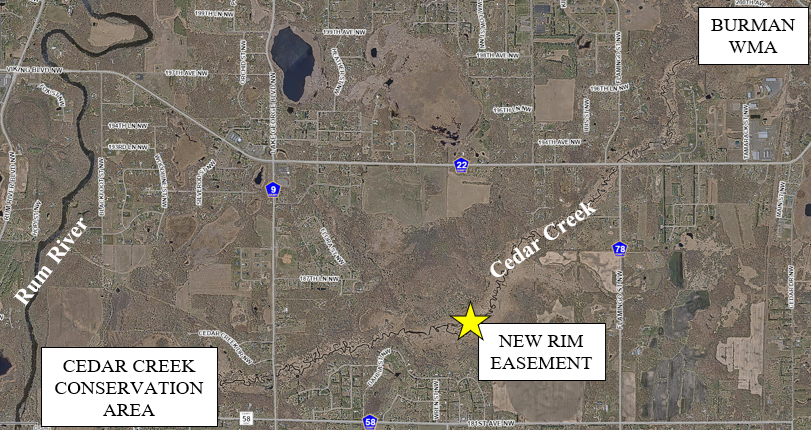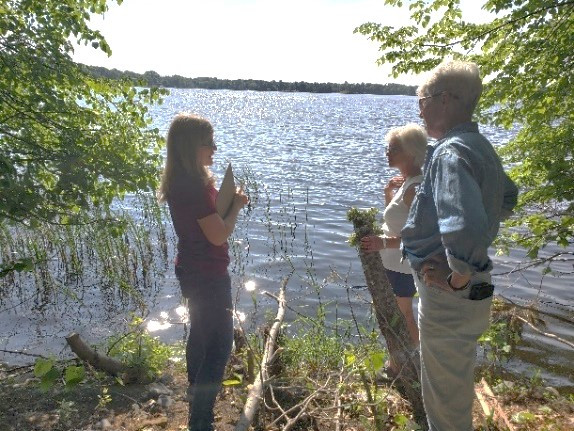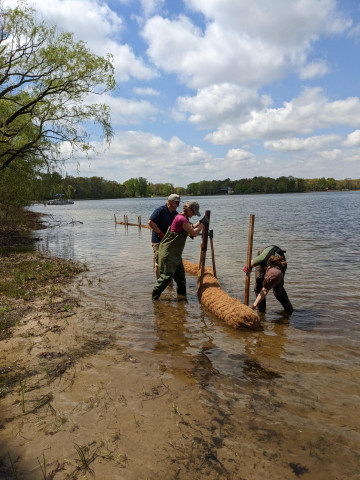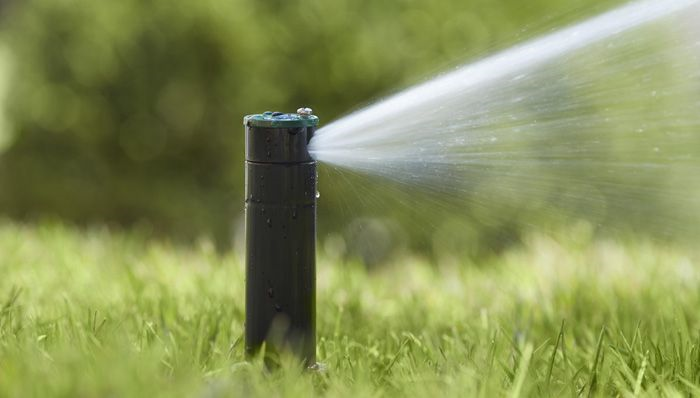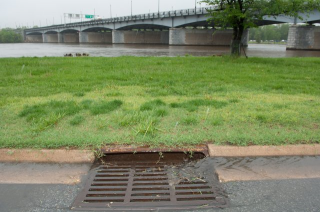The Sloneker family protected 58.5 acres of their land around Cedar Creek through the BWSR's Reinvest in Minnesota (RIM) program. Under the RIM program, the land remains privately owned but is protected by a conservation easement. Land protection along creeks and rivers improves water quality, reduces flood risk, and creates essential wildlife habitat corridors. For more information contact Carrie Taylor, Restoration Ecologist, at
Vernal pools are shallow wetlands that fill with water in the spring and fall, then often dry out in the summer. They may appear like large puddles, but these depressions are brimming with life and help improve water quality. By capturing water from snowmelt and heavy rainfall, vernal pools reduce the amount of runoff (and therefore the contaminants it carries) reaching nearby surface waters and developed lands. This lowers flooding risks, improves water quality, and contributes to groundwater recharge as the trapped water slowly infiltrates through the soil.
Vernal pools rarely contain fish because their water levels fluctuate dramatically. This creates a safe haven for many amphibians and aquatic invertebrates that would otherwise be heavily preyed upon. While some depend on vernal pools during only their vulnerable egg and larval stages, others spend their entire life within or near them. These small wetlands also provide food, water, and refuge for many other wildlife species such as ducks, turtles, and snakes. Benefits stem beyond the pool itself as several aquatic insect larvae transform to flying adults, serving as forage for insectivores like songbirds and bats.
Vernal pools are highly sensitive to environmental changes. Because they are nearly invisible for much of the summer, they can be easily missed and destroyed if the land is modified. You can help protect vernal pools on your property by noting their boundaries when visible in the spring and avoiding disturbance throughout the year. This is also a great time to explore the abundance of wildlife in and around these wetlands! For more information contact Breanna Keith, Water Resource Specialist, at
Additional Resources
"Spring-to-Life Ponds": an Illustrated Learning Guide, produced by the MNDNR
MN Frog ID and Calls and Common Vernal Pool Invertebrates, produced by the MPCA and the University of Wisconsin
Locating and Protecting Vernal Pools, produced by the MN Land Trust
Stephanie Finch was hired as ACD's Seasonal Technician. Stephanie holds a B.S. degree in Earth Sciences from the University of Minnesota with a specialization in groundwater and geomorphology. She brings experiences from the Aitkin SWCD, the Minnesota GreenCorps program, and a seasonal position with the Minnesota Pollution Control Agency, collecting water quality samples across the state. She is excited to work in Anoka County's diverse range of landscapes and hopes to learn more about the county over the next few months!
Jonn Olson was the recipient of the annual "Friend of Martin Lake" award at the May 2024 annual meeting of the Martin Lakers Association. Jonn, along with the Linwood Township maintenance crew, was instrumental during spring 2023 flooding. They helped ensure water continued to flow when bogs were threatening to clog water structures. Jonn is a Linwood Township Supervisor and member of the Sunrise River Watershed Management Organization. The Friend of Martin Lake award originated in the early 2000's, when ACD presented it to the Martin Lakers Association. It has been a traveling annual award ever since.
For more information contact Jamie Schurbon, Watershed Project Manager, at
ACD was recently awarded National Fish and Wildlife Foundation Monarch Butterfly and Pollinators Conservation Funds to increase habitat for the monarch butterfly and other pollinators. ACD is collaborating with Sherburne County Parks and Great River Greening to restore and enhance habitat and create pollinator corridors within the Anoka Sand Plain region. This funding will help support and expand state programs such as the Anoka Sand Plain Partnership and the BWSR Habitat Enhancement Landscape Program.
Sherburne County Parks will coordinate restoration and enhancement activities at Bdé Heḣáka, Omashkooz Zaaga'igaans Regional Park, a new park in coordination with Tribal Historic Preservation Officers from the Upper and Lower Sioux Community and Mille Lacs Band of Ojibwe to restore land through traditional cultural methods. Great River Greening will coordinate projects to enhance large habitat corridors in Sterns, Sherburne, Chisago, Wright, Anoka, Benton and Morrison counties. ACD will coordinate projects within Anoka County.
Unused lots, agriculture fields that are out of production and turf will be restored to create new habitat by planting native milkweed and wildflowers. Degraded lands that have little to no milkweed and forbs will be enhanced by controlling invasive species and conducting prescribed burns. ACD will be hosting events to plant, collect seed, and participate in a national Integrated Monarch Monitoring Program. Details on volunteer opportunities are coming soon! For more information contact Carrie Taylor, Restoration Ecologist, at
Twenty-years ago we designed conservation projects with a tape measure and graph paper. Over the years, ACD has gone high tech. Today we use a survey-grade GPS (shared with neighboring SWCDs) and landscape design software. This allows precise measurements and estimates of quantities. It also allows us to clearly communicate a project's outcomes to landowners and contractors. But we still pull out the tape measure once in a while – it never crashes or fails to connect.
We're the private lands conservation experts! We provide financial resources and expertise to help private landowners with conservation efforts on their property that also have public benefits. Minnesota is a unique state, with an SWCD in nearly every county to assist with work on the ~70% of Minnesota's lands that are private. ACD is simply an SWCD that shortened its name. In comparison, the well-known MN Department of Natural Resources (DNR) manages public lands and resources.
For more information about SWCD's and the role they play within the state, contact
Jamie Schurbon, Watershed Program Manager,
The Anoka Conservation District (ACD) has been a long-time partner of Conservation Corps Minnesota & Iowa (CCMI) and this tradition continues in 2023. This year, ACD was awarded 32 CCMI crew days to be used towards implementing streambank stabilization practices along the Rum River in Anoka County. Crews are deployed, a week or more at a time, to a specific project site. ACD will act as the project host to coordinate projects, provide equipment and materials, and utilize ACD's expertise for extensive on-site training and education.
The majority of Corpsmembers are recent college graduates and these field crew positions provide members the opportunity to learn how soil and water conservation districts and other professional organizations operate. ACD strives to provide in-depth training on project installation, project goals, site identification, and touch on other critical aspects of a project. Additionally, extensive time in the field allows ACD staff get to know the Corpsmembers and contribute insight into their professional development and growth within their career path.
CCMI field crews serve the greater outdoors by restoring habitat, managing natural resources, and occasionally responding to natural disasters or emergency needs of a community. The Field Crew program prioritizes personal and professional growth while teaching hands-on conservation skills in the field. Corpsmembers develop technical skills throughout their term while completing challenging and impactful conservation projects. Many projects are performed in partnership with public land management agencies such as the Department of Natural Resources, US Fish & Wildlife Service, National Park Service, cities, counties, and trail associations.
Working in a field crew blends hard work, community service, and environmental stewardship while also gaining additional life-long skills. Corpsmembers often have a transformational experience during their term, leaving them feeling more prepared for whatever comes next.
Visit the Conservation Corps website to learn more about the organization and available career opportunities.
When projects are installed, ACD staff calculate and document the benefits produced by them. Measurable benefits for water resource improvement projects include metrics such as nutrient and sediment reductions to local waterbodies. For ecological projects, the total area restored or enhanced is quantified. Until recently, these numbers lived in project-specific documentation, but they can now be viewed altogether in ACD's new interactive projects dashboards.
With dashboards, you can explore the cumulative benefits produced through projects such as habitat restorations, streambank stabilizations, pollinator plantings, and stormwater best management practices. Many projects have multiple benefits; for example, rain gardens trap and filter polluted stormwater while also providing habitat for pollinators. Altogether, these tools provide a user-friendly way to track achievements within and across years.
You can apply filters based on location, date range, and project type. For example, selecting the "Last Year" option in the date range dropdown will give you a summary of all conservation benefits achieved in 2022. Pan throughout the map and click on the points to learn more about individual projects. The gauges will adjust to summarize the benefits produced by the projects you're viewing.
ACD Contact: Breanna Keith,
Here's our version of a popular kid quiz game. Below are sets of three statements. Can you tell which one is the lie? See answers at the bottom of the page!
#1: About the Anoka Conservation District's (ACD) origins…
- a) ACD began with the purpose of replanting trees lost to the devastating 1939 Anoka tornado.
- b) We started in 1946 with focus on stemming Dust Bowl era erosion.
- c) ACD was brought into existence by the voters of Anoka County through a referendum.
#2: About the Anoka Conservation District (ACD)…
- d) We're a department of Anoka County that focuses on natural resources issues.
- e) ACD's elected Board of Supervisors sets the policy and direction of the District and staff work to bring it to fruition.
- f) Our staff of 12 includes experts on water quality projects, upland habitat restoration, wetlands, and more.
#3: About ACD's function…
- a) ACD offers technical and financial incentives to encourage conservation activities and works with willing landowners to make them happen.
- b) By creating reasonable standards and issuing permits, we are able to stem negative impacts of development.
- c) We keep our finger on the pulse of our natural resources with an extensive program of monitoring and inventory done in partnership with water management entities.
#4: About ACD's funding…
- a) At $0.41 per capita for general services, ACD funding from the county is the lowest funded soil and water conservation district in MN.
- b) ACD invented, patented, and sells a product that has over $500K in annual sales.
- c) In 2022 our elected supervisors reduced our tax levy by 5%.
#5: ACD's accomplishments…
- a) In 2021 we installed 66 projects for water quality and habitat.
- b) We simultaneously manage 10 different grants that are used for projects.
- c) Our biggest project in 2021 was nearly ¼ mile of stabilized Mississippi Riverbank.
#6: Collaborations…
- a) ACD serves as the contracted administrator for three watershed organizations to reduce duplication and coordinate.
- b) Cities, lake associations, watershed groups, and landowners voluntarily contribute match to help us secure grants for projects of mutual interest.
- c) We spend a lot of time working with people who are under mandatory permit requirements to do conservation projects.
#7: Stuff we'll help you pay for…
- a) Our Lawns to Legumes program encourages pollinator habitat. (Legumes are a class of veggies including beans, peas, & clovers).
- b) Our Green Fields, Blue Water Initiative with the Minnesota Twins will install "smart" irrigation systems on community baseball fields to avoid watering when rain is in the immediate forecast or a game is scheduled to be played.
- c) Our Septic Fix Up grants help folks in deep crap with repair or replacement a failing septic system. It helps protect lakes and groundwater.
#8: Office life…
- a) We have "companion ducks" at the office to calm our nerves. When they migrate in winter, staff get pretty edgy. Call during summer.
- b) We celebrate casual Fridays on Thursdays. When actual Friday arrives, it's a little depressing. Call before Friday.
- c) Our staff "wellness program" is all about encouraging naps. Life is a race already. Please call after nap time.
ANSWERS
#1: The lie is (a) -- While the 1939 tornado was devastating, it was the Dust Bowl era of drought that prompted a need to connect farmers with practices that were less erosion-prone. We have evolved to include urban and sub-urban conservation practices.
#2: The lie is (a) -- ACD is not an Anoka County department. We are separate, with our own elected supervisors.
#3: The lie is (b) -- We don't have any regulatory authority nor issue permits. We work with willing landowners only.
#4: The lie is (c) -- We don't have tax levy authority. We do receive some funds from the county and grants that originate from taxpayers, but we control none of it.
#5: The lie is (b) -- At any given time we have 20+ different grants totaling over 4 million dollars!
#6: The lie is (c) – We work with willing landowners only. We don't do regulation.
#7: The lie is (b) -- Nice idea, but not yet reality. Consider smart irrigation for your home.
#8: The lie is…all of them. :)
Anoka Conservation District recently submitted two proposals, HRE07 Rum River Corridor Fish and Wildlife Habitat Enhancement – Phase 2 and HA02 Anoka Sand Plain Habitat Conservation – Phase 8 to the Lessard-Sams Outdoor Heritage Council ML 2023 Request for Funding. The proposed activities will enhance aquatic and terrestrial habitat in Anoka County and collaborate with Partners in the Rum River Corridor and the Anoka Sand Plain Ecoregion.
HRE07 Rum River Corridor Fish and Wildlife Habitat Enhancement – Phase 2
$3.5M request ($3M for Anoka County) includes:
- Streambank and in-channel stabilization (2,200 linear feet);
- In-stream fish habitat with a focus on game fish (1,200 linear feet); and
- Riparian forest, wetland, and prairie enhancement in the Shoreland Zone (118 acres) including wild rice habitat on tribal lands.
Partners:
- Anoka, Isanti and Mille Lacs SWCDs
- Anoka and Isanti Counties
- Upper and Lower Rum River WMOs
- The Nature Conservancy
- Mille Lacs Band of Ojibwe
HA02 Anoka Sand Plain Habitat Conservation – Phase 8
$8.9M request ($2.15M for ACD) includes:
- Conservation easements (540 acres)
- Habitat restoration and enhancement (1,736 acres and 2,200 linear feet of shoreline)
- Rare plant rescue program
If you are looking to develop your knowledge of the outdoors this summer, consider the Minnesota Outdoors Skills and Stewardship webinar series being offered by the Minnesota DNR. The webinars take place every Wednesday through the month of August and are less than an hour long. These training webinars are structured towards the general public and can be beneficial for someone who is brand new to a topic or for someone who is experienced but is looking for a refresher. Each weekly webinar covers a different topic. Topics range from "Forging on the North Shore" and "How to Harvest Wild Rice" to "New Deer Regulations" and "Smallmouth Bass River Fishing".
This training series is unique because attendees get the opportunity to learn from some of the top professionals in the state who are leading experts within their field. For people who are busy, this is a great way to learn new skills without having to commit a ton of time and resources. You can also access previously recorded webinars providing you hours of fantastic resources.
Sign up today and give one a try! Follow the link below to view the upcoming training schedule and get access to past webinars.
https://www.dnr.state.mn.us/fishwildlife/outreach/index.html
Spring is here. If you have an irrigation system for your yard, you're likely considering getting it up and running within the next month or two. System startup is the time when you're setting the watering duration and frequency for each zone in your yard. These settings often remain unchanged throughout the season, which typically results in overwatering. Overwatering wastes drinkable water, and assuming you don't have a private well, it also wastes money.
This year, in addition to following city restrictions (e.g. odd/even watering schedules), try actively managing your irrigation controller. Active management consists of adjusting run times based on local conditions. For example, during periods with sufficient rainfall, watering duration and frequency can be reduced. During these times, you can simply turn your irrigation system off. In contrast, during periods of extreme heat and drought, supplemental watering may be necessary. Watch your yard for signs of drought before turning on your irrigation system, and rely on rainfall as much as possible. When you need to use your irrigation system, water your lawn one time or less per week with a good soaking to encourage deeper root growth, and schedule watering times in the morning to reduce evaporation associated with midday heat and wind.
An alternative to active management is a smart irrigation controller. Smart irrigation controllers use an internet connection to actively monitor local precipitation patterns and automatically adjust watering frequency and duration accordingly. Regardless of whether you choose active management or a smart irrigation controller, both are effective options for reducing water use and saving money.
Visit the University of Minnesota Extension's Lawn Care website for additional lawn management resources.
Anoka CD, in partnership with Rice Creek Watershed District, Coon Creek Watershed District, City of Fridley, Coon Rapids, Blaine and Lino Lakes, received BWSR grant funds to create a pollinator corridor in the North Metro. These cost share funds are available to local residents and public spaces (e.g. places of worship and libraries) who are interested in creating pollinator habitat. Eligible projects include native pocket plantings, pollinator beneficial trees and shrubs, pollinator lawns and pollinator meadows to benefit the rusty patched bumblebee and other at-risk species.
Contact Carrie at
Current subzero temperatures can make warmer months seem far away, but winter is a great time to begin planning for spring and summer conservation projects at your home. Whether you want to create an oasis for pollinators and other native wildlife or install features that improve local water quality, there are many great informational resources to help you get started.
Create a native vegetation planting plan and control invasive species
Establishing areas of diverse native vegetation and managing invasive plant species produces multiple environmental benefits, including the provision of food and habitat resources for native wildlife and the improvement of local soil and water health, particularly for areas adjacent to rivers, lakes, and wetlands. Sourcing native plants and landscaping services from local experts is the best way to ensure your efforts maximize ecological benefits in your area.
- ACD native tree, shrub, and seed sale: https://www.anokaswcd.org/tree-sale-order-forms/instructions.html
- MNDNR lists of native plant suppliers and landscapers: https://www.dnr.state.mn.us/gardens/nativeplants/suppliers.html
- Native plant lists and planting tips: https://extension.umn.edu/find-plants/native-plants
- Invasive plant identification and management: https://www.dnr.state.mn.us/invasives/terrestrialplants/index.html
Address lawn care needs sustainably
The ways in which we mow, irrigate, and chemically treat our yards can lead to unintended impacts in nearby aquatic and terrestrial ecosystems. This year, consider developing a lawn care regime that strategically targets nutrient and pesticide needs and reduces the need for irrigation.
- MPCA lawn and garden care tips for a healthy environment: https://www.pca.state.mn.us/living-green/yard-and-garden
- Achieving a sustainable lawn: https://doitgreen.org/topics/gardening/achieving-sustainable-lawn/
- Pollinator-friendly pest control: https://xerces.org/sites/default/files/2019-09/19-034_01_Protecting%20Pollinators%20at%20Home_web.pdf
Participate in community surveys and attend educational events
Winter is a great time to explore environmental topics that pique your interest and inspire you to become involved in backyard conservation efforts. Many of Minnesota's environmental and conservation organizations provide free or low-cost educational opportunities such as webinars and workshops. You can also become involved in natural resource surveys such as those for wildlife, weather, and water quality, which greatly improve our understanding of conservation needs across the state.
- MNDNR Natural Resources Education Opportunities: https://www.dnr.state.mn.us/education/index.html
- University of Minnesota Extension courses and events: https://extension.umn.edu/courses-and-events?search=&end_date=&start_date=&subject%5B676%5D=676&page=1
- MN Zoo backyard science and conservation opportunities: https://mnzoo.org/educator-corner/conservation-citizen-science/
- MPCA citizen science: https://www.pca.state.mn.us/water/citizen-water-monitoring
Financial and Technical Assistance
Because environmental benefits produced through conservation practices typically extend beyond the bounds of your property, conservation projects such as lakeshore restorations, riverbank stabilizations, and best management practices for urban or agricultural stormwater runoff may qualify for financial or technical assistance. Seeking out and applying for these opportunities early will help you get a strong head start on spring and summer projects.
- Anoka County financial and technical assistance opportunities: https://www.anokaswcd.org/financial-technical-assistance.html
- Statewide grant options: https://mn.gov/grants/#/list/appId/0/filterType/Tag/filterValue/Natural%20Resources/page/1/sort//order/
The Lower St. Croix Partnership, formed through the "One Watershed, One Plan" process, has been selected to receive a County Conservation Award from the Association of Minnesota Counties (AMC). The award, developed in partnership with the Minnesota Board of Water and Soil Resources (BWSR), recognizes leadership, innovation, and excellence in protecting or improving natural resources.
This year's award recognized the partnership's success forging relationships that cross the urban-rural divide, and working collaboratively to protect and improve the St. Croix River, groundwater, lakes, streams, rivers, wetlands, and upland habitat. The partnership is sharing regional education staff and a regional agricultural outreach specialist. We are also completing a wide variety of water quality projects including stormwater treatment, erosion stabilization, enhanced street sweeping, and many more. The group follows a 10-year management plan they created together, and utilizes state grant funding for much of its work.
The Anoka Conservation District and Sunrise River Watershed Management Organization represent the Anoka County area in the Lower St. Croix partnership. Learn more at lsc1w1p.org.
Written by: Jamie Schurbon, Watershed Projects Manager
When I was young, there was a woodlot in the neighborhood where kids, including me, roamed. It was along the river, where there were frogs to be caught. We built forts. We played games. It felt like 100 acres, but in hindsight was probably just a few. That natural area was, apart from the people, a most memorable part of the neighborhood.
What's the best part of your neighborhood? Perhaps it's a woodlot on your own property. Or a wetland the provides a little privacy. Or just a few big mature trees. We get joy from living in natural surroundings big or small. When these things are lost, the neighborhood seems to sigh in disappointment (and some folks get downright upset).
Conservation easements are one tool available to landowners who want to ensure their land is kept natural for the long term, as a legacy for the community. Conservation easements pay landowners in exchange for a restriction on certain types of changes, such as clearing and building, to the land in the future. The easement runs with the land and applies to future owners.
The newest easement program available in Anoka County focuses on properties along the Rum River. Riverbank properties are critical to the scenic and recreational qualities of the river, as well as the river's ecological quality. The program pays 60% of the assessed value of the land. You set the easement boundaries. You retain ownership. The land does not become open to the public.
Easements are purchased strategically. While many lands are eligible, not all are competitive candidates. Those that score highest are parts of larger high quality natural areas and will not become "islands" within development. Easements should help retain community character and be consistent with anticipated growth.
If you are interested in having your land considered for a conservation easement, please contact Carrie Taylor at 763-434-2030 ext. 19 or
The Rum River is one of the largest rivers in Anoka County, second only to the mighty Mississippi. It starts at the outlet of Mille Lacs Lake and winds through the landscapes of Mille Lacs, Isanti, and Anoka Counties until it discharges to the Mississippi River in the City of Anoka—but many don't know about the progress this river has made to become one of Minnesota's most outstanding waterways.
To really appreciate the Rum River today, it's good to understand a bit of its history. For many decades, the Rum River served as a large scale aquatic conveyor for lumber. Large white pine, elm, oak, cherry, and maple all floated down the river from central Minnesota forests to build the homes and business of the growing Twin Cities Metro Area. It also conveyed our sewage, agricultural waste, sediment laden runoff, and industrial by-products downstream to the Mississippi River, and eventually the Gulf of Mexico.
A former Anoka County commissioner who grew up in the area once said that when he was a kid, no one would dare to even fish in the Rum River, much less swim in it. I'm happy to say, over the last 80 years, the fate of the Rum River has been wholly reversed. Today the Rum River is:
- One of 6 Wild and Scenic Rivers and 35 State Water Trails in Minnesota
- Designated as an Outstanding Resource Value Water
- An excellent fishery and waterfowl corridor with abundant smallmouth bass and wood duck
- Key reach for Species in Greatest Conservation Need
This isn't to say that our Rum River is in the clear. In the last 30 years, the population in the area draining to the Rum River has increased by 47%. With that many people came more roads, parking lots, and roof tops that added 74% more stormwater runoff. The increased water volume and speed that came with this extra stormwater caused the river to slice deeper into the landscape and rip apart the riverbanks. When riverbanks collapse into the river, the resulting sediment smothers the fish, amphibians, and reptiles that now call the river home. The Rum River is also increasingly threatened by road salt and nutrient pollution coming from this stormwater.
ACD takes a holistic approach to managing these new challenges to the quality of the Rum River. We are heavily involved with monitoring the chemistry and biological quality of the River; we assist the local Watershed Management Organizations with analysis and planning; and we implement projects with willing landowners to improve water quality and habitat in the river. ACD is also involved with guiding land conservation projects near the Rum River needed to protect habitat and water quality, and we are working diligently with other local organizations to ensure future funding for projects protecting the Rum River.
Over the coming months, we will be posting short blogs to highlight individual projects and programs that ACD has directed for the benefit of the Rum River. Check in soon at www.anokaswcd.org/blog to learn more!
